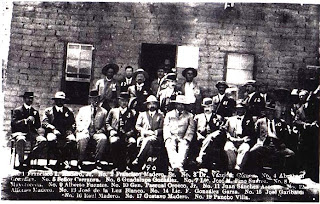- Benito Juarez: the first Mexican leader who did not have a military background, and also the first full-blooded Aboriginal to serve as the President of Mexico and to lead a country in the Western Hemisphere
- Porfirio Diaz: Commonly considered a dictator, he is the President of Mexico for 35 years, with the exception of his temporary resignations. His conservative regime grew unpopular due to repression and political continuity, and he fell from power during the Mexican Revolution
- After his death in 1872, Porfirio Diaz took over as Mexico's leader
The Beginning
After the hostility towards Diaz's rule, Francisco Madero moved into office and became the President of Mexico. Before Election Day, however, Diaz had Madero jailed and then declared a "victory" in the elections.
Madero escaped from jail and spent a short time in San Antonio, Texas. He issued a “letter from jail” following the elections, which he won by a landslide, that called for a revolt. It condemned Diaz for taking office and declared his rule illegal. Madero promised free suffrage and no-reelections. He called for a revolution to begin November 20th, 1910.
The Revolution
Leaders of the 1910 revolt
Madero drew support from many of the citizens, ranging from all over the social hierarchy. After defeating Diaz’s army, Madero took control and began to reform the Mexican government. He welcomed in a democratic government that was semi-controlled by the foreign investors.
The reformation, while starting to make things better for most Mexicans, didn’t go far enough. As a result, one of Madero's supporters broke ranks and formed his own army to demand social reformation for better pay, better working hours and better work conditions. In an unexpected coup d’etat led by the Commander-in-Chief that was appointed by Madero when he took control, the power in Mexico had once again shifted. Madero resigned in 1913 and both he and the vice president were assassinated within a weeks time. Both are remembered as martyrs of the revolution.
There was very little involvement in the Mexican Revolution by the United States.
The End
http://www.mexconnect.com/articles/2824-the-mexican-revolution-1910
http://en.wikipedia.org/wiki/Mexican_Revolution
http://en.wikipedia.org/wiki/Porfirio_D%C3%ADaz
http://en.wikipedia.org/wiki/Benito_Ju%C3%A1rez
Madero escaped from jail and spent a short time in San Antonio, Texas. He issued a “letter from jail” following the elections, which he won by a landslide, that called for a revolt. It condemned Diaz for taking office and declared his rule illegal. Madero promised free suffrage and no-reelections. He called for a revolution to begin November 20th, 1910.
The Revolution
Leaders of the 1910 revolt
Madero drew support from many of the citizens, ranging from all over the social hierarchy. After defeating Diaz’s army, Madero took control and began to reform the Mexican government. He welcomed in a democratic government that was semi-controlled by the foreign investors.
The reformation, while starting to make things better for most Mexicans, didn’t go far enough. As a result, one of Madero's supporters broke ranks and formed his own army to demand social reformation for better pay, better working hours and better work conditions. In an unexpected coup d’etat led by the Commander-in-Chief that was appointed by Madero when he took control, the power in Mexico had once again shifted. Madero resigned in 1913 and both he and the vice president were assassinated within a weeks time. Both are remembered as martyrs of the revolution.
There was very little involvement in the Mexican Revolution by the United States.
The End
- Military: the revolution ended with the death of Venustiano Carranza in 1920, and the increasing power of General Alvaro Obregon
- Many believe it ended in 1930, when most of the reformations had happened
http://www.mexconnect.com/articles/2824-the-mexican-revolution-1910
http://en.wikipedia.org/wiki/Mexican_Revolution
http://en.wikipedia.org/wiki/Porfirio_D%C3%ADaz
http://en.wikipedia.org/wiki/Benito_Ju%C3%A1rez
